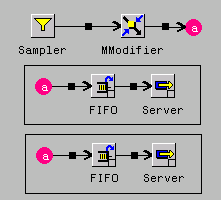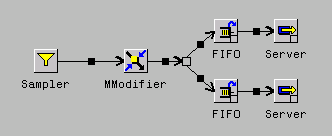Chapter Contents
Previous
Next
|
Chapter Contents |
Previous |
Next |
| Building a Model with Elementary Components |
| Icon | Component | Description |
| Port | for connecting multiple components | |
| Connector | for connecting multiple components without using arcs | |
| Label | for annotating the model |
Figure 2.20 shows an example with a connector labeled "a." When a transaction flows into connector "a," it will flow out of all other connectors "a."

|
The three "a" connectors are treated as identical. An equivalent model using an instance of a Port is shown in Figure 2.21.

|
Here, you see the port explicitly connects the three components, which were implicitly connected using the Connector. In addition, ports have a special role in compound components. In this setting they can be used to create special connections from the outside of compound components to the inside of compound components. See Chapter 5, "Building a Model with Compound Components," for more details on this special function.
You duplicate a Connector by selecting Duplicate on the pop-up menu. If you type in the interior of the Connector, then all the duplicates of that connector will display the same text.
|
Chapter Contents |
Previous |
Next |
Top |
Copyright © 1999 by SAS Institute Inc., Cary, NC, USA. All rights reserved.